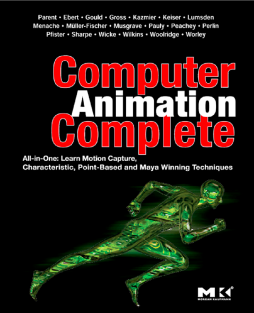
BOOK
Computer Animation Complete
Rick Parent | David S. Ebert | David Gould | Markus Gross | Chris Kazmier | Charles John Lumsden | Richard Keiser | Alberto Menache | Matthias Müller | F. Kenton Musgrave | Mark V. Pauly | Darwyn Peachey | Ken Perlin | Hanspeter Pfister | Jason Sharpe | Mark R. Wilkins | Martin Wicke | Nicholas Woolridge | Steve Worley
(2009)
Additional Information
Book Details
Abstract
A compilation of key chapters from the top MK computer animation books available today - in the areas of motion capture, facial features, solid spaces, fluids, gases, biology, point-based graphics, and Maya. The chapters provide CG Animators with an excellent sampling of essential techniques that every 3D artist needs to create stunning and versatile images. Animators will be able to master myriad modeling, rendering, and texturing procedures with advice from MK's best and brightest authors.
Divided into five parts (Introduction to Computer Animation and Technical Background, Motion Capture Techniques, Animating Substances, Alternate Methods, and Animating with MEL for MAYA), each one focusing on specific substances, tools, topics, and languages, this is a MUST-HAVE book for artists interested in proficiency with the top technology available today! Whether you're a programmer developing new animation functionality or an animator trying to get the most out of your current animation software, Computer Animation Complete: will help you work more efficiently and achieve better results. For programmers, this book provides a solid theoretical orientation and extensive practical instruction information you can put to work in any development or customization project. For animators, it provides crystal-clear guidance on determining which of your concepts can be realized using commercially available products, which demand custom programming, and what development strategies are likely to bring you the greatest success.
- Expert instruction from a variety of pace-setting computer graphics researchers.
- Provides in-depth coverage of established and emerging animation algorithms.
- For readers who lack a strong scientific background, introduces the necessary concepts from mathematics, biology, and physics.
- A variety of individual languages and substances are addressed, but addressed separately - enhancing your grasp of the field as a whole while providing you with the ability to identify and implement solutions by category.
"Computer Animation Complete sets the stage with a well written introduction. In this section, the first chapter discusses some of the key events in the history of animation to introduce the principles of animation and film making. This chapter is written at a non-technical level and makes very interesting reading for anyone interested in animation. The target audience, however, is experienced animators. This book does not disappoint."--School Tech Talk Blog and MacDirectory.com
